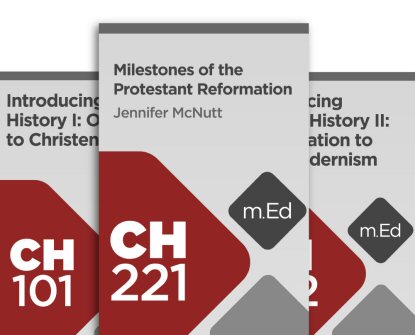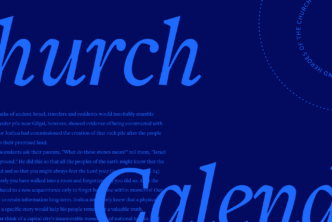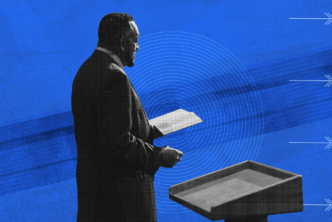From the window of graduate student housing at Emory University, my mother recalls watching an older man carrying a heavy sack and placing a book at the doorstep of each of the apartments, one after the other.
And then this St. Nicholas-like man came to her door, and he placed the mysterious book there and departed.
The book, as it turned out, was the American Bible Society’s Good News Bible.
Despite little to no direct familiarity with the Bible, she brought it inside with some curiosity. She was an English major after all; she figured she should probably know something of what the Bible was about.
She committed to reading the New Testament at twenty-five pages per day, a dutiful reading plan well suited for such a monumental book.
By the time she reached Luke’s Gospel, she had accepted Jesus as Lord and Savior.
She could not have known then that her encounter with the Bible on the doorstep that day would completely transform not only the trajectory of her life but also that of her children.
Because of that Bible, I grew up in a Christian home where both my parents served in church ministry. We were the first ones to arrive at church and the last ones to leave. I can’t even remember a time when I did not know Jesus and the Bible.
In a way, that Bible on her doorstep became itself a kind of doorstep for new life for her and the generations to come.
Sometimes all it takes is just one Bible.
The Bible’s journey
The Bible’s journey to our doorsteps today is remarkable to trace and something every Christian can come to know to enrich their faith.
The fact that Scripture was written by numerous authors over the span of many centuries in the languages of Hebrew and Greek—and then compiled, copied, translated, and disseminated worldwide is a wonder.
From the calligrapher’s pen to the printer’s page to the Bible app screen; from papyrus to animal skins to rags to wood pulp and then liquid crystals; the Bible keeps making its way to us no matter the geography, century, or technology.
And when we dig into the twists and turns of that journey, we soon come face-to-face with the importance of the Reformation period for the Bible.
A good question to ask is: What happened to the Bible during the Reformation?
It’s certainly a complex topic that deserves a complex answer, but no answer can ignore the unexpected influence of Martin Luther and one Bible that paved the way for a new era of Bible translation.
An unexpected influencer
It could not have been predicted that an unknown professor and Augustinian friar teaching at the university of an out-of-the-way town such as Wittenberg, Saxony, would have such a significant and enduring impact on the church and Western society, the printing industry, and the expansive reach of the Bible worldwide.
Martin Luther was training to be a lawyer when a near-death experience with a lightning bolt led him right into the arms of the monastery.
It soon became apparent that he had an astute mind for theology, and he was given the opportunity to take up a professorship at the Prince of Saxony’s brand-new university in Wittenberg.
His Ninety-Five Theses, which protested the abuse of indulgences in 1517, may have been the spark that generated the reforming movement across Europe, but his translation of the Bible into German was the flame.
The year that Luther’s German New Testament was published in 1522, he became the most published author in Europe ever.1
In fact, when we talk about the Bible today as a worldwide publishing best seller, it’s worth exploring how five hundred years ago Luther’s German New Testament paved a way.
From trouble to translation
After being excommunicated by Pope Leo X and banned by Holy Roman Emperor Charles V, Luther was whisked off to Wartburg Castle by the Prince of Saxony to avoid what seemed at the time to be certain imprisonment and death. Authorities were playing a round of ping pong with him, but he still managed to use the time wisely.
Hidden away and without assurances for his future, this outlaw of church and state turned his attention to the New Testament.
Using the resources and training of Renaissance humanism, dedicated as it was to language, grammar, and text, Luther began the task of translating the New Testament into German.
Specifically, he employed Desiderius Erasmus’s Latin and Greek New Testament, the 1519 edition,2 to root his translation in the original New Testament language. With the assistance of his colleague and Greek-language expert Philip Melanchthon, the translation was completed in eleven weeks.
After his return to Wittenberg and in order to finish the print in time for the Leipzig Book Fair (Sept. 29–Oct. 6),3 three presses were cleared in the city. The size and complexity of the print task was the most significant print job undertaken in Wittenberg to that point.4
Luther’s unauthorized best seller
Luther’s achievement was a folio that would come to be known as the “September Testament.” His name was nowhere to be see on the title page—though his authorship was frankly no mystery given the Wittenberg imprint.
Although it was immediately banned by Duke George of Saxony, Frederick’s cousin, the September Testament received the warmest of welcomes by the populace.
It sold an unprecedented 3,000 copies or more in its first run, requiring an immediate second edition issued in December 1522.5
Over time, Luther’s Bible became more accessible as it moved from the very large folio format to quarto then the quite manageable octavo size.
Meanwhile, numerous reprints, official and unofficial, began to flood the market.
Against all odds, Luther’s unauthorized German New Testament turned out to be a printing phenomenon. It was nothing short of a sensation with 115 editions in his lifetime alone.6 By his death in 1546, Luther’s complete German Bible, first published in 1534, had sold half a million copies.7
For the five hundredth anniversary of the Reformation, the department of the United Nations known as UNESCO declared it one of the most important documents of the world’s written tradition for its selective and prestigious World Documentary Heritage Program.
A remarkable (and unremarkable) feat
It was an impressive achievement all around from completing the project itself (first the New Testament and eventually the Hebrew Bible) to its dissemination through print and printers to its enthusiastic reception among the populace.
Considering that the printer Johannes Gutenberg’s Bible project of the mid-fifteenth century left him bankrupt, Bible publishing was still a risky business until Luther came along.
These are some of the reasons that we should not take his success for granted. But to understand what was remarkable about it we must also understand what was unremarkable about it.
For one, Luther’s German New Testament was not the first German New Testament. That’s a common misconception.
Actually, there were a number of other German Bible translations before his.
And so, the next logical question to ask is what made Luther’s Bible translation different? What made the Reformation Bible different?
It may help to know that prior to Luther’s German New Testament, vernacular Bibles of the medieval period were translations of the Latin Bible or Latin Vulgate.
In fact, there was a hierarchy of language, because it was believed that Latin was the sacred language of the church. Latin was the language of worship.
Vernacular Bibles had a place in the life of the church as translations of a translation geared towards devotional purposes, and they very often leaned into the genre of paraphrase.
And so, what Luther’s German New Testament did was break ranks. By rooting his translation in the Greek, he began a process of setting it on par with the Latin Bible or Vulgate in authority and purpose.
It’s the difference between John Wycliffe’s translation of the Bible into English and William Tyndale’s. Both are important, but they did not carry the same purposes in their eras.
Eventually, that kind of shift transformed the language of worship and liturgy as it also elevated the value and function of Scripture in common languages.
These changes did not come out of nowhere.
To be sure, the importance of transmitting the Bible in written form came from medieval commitments to the Scriptorium. The importance of recovering original languages was owed to the Renaissance.
This pre-context shaped a waiting market8 poised to embrace more exposure, knowledge, and access to the biblical text (see Andrew Gow’s work)—an access that only the printing press could offer at an unprecedented scale.
Even so, the connection that Luther managed to create between the reader and the German New Testament was a testament to his skill and professor-pastor-preacher’s eye.
Professor-pastor-preacher at work
The formatting and language of the September Testament are factors most often recognized as key to its popularity.
The New Testament was laid out for simple reading, with one single column of text and marginal notes to explain word selection and interpretive points.9
In this way, Luther’s New Testament struck a balance between a medieval Bible that was often overwhelmed by glosses and a Renaissance Bible that refocused the reader on the Bible text.
The appeal of Luther’s New Testament has also been recognized in his skill as a communicator and translator.
Luther had a knack for negotiating dynamic equivalence (so that the ideas are understood) and grammatical equivalence (so that the German words are truly reflective of the Greek meaning of Scripture) in a compelling way.
By all accounts—even those of his enemies!—Luther’s translation achieved a readability level in word and style that excelled.
He paid attention to idiomatic phrases. The German spoken in the marketplace was even mimicked and codified in a flood of editions that followed.
Today we recognize that he was shaping the German language at a time when no single High German dialect existed.10
Eric Gritsch writes, “If the German Bible had not become the most popular book in German households, a common German language would not have been born.”11
That readable style played a significant role in reaching readers and listeners—and elevating Luther’s Bible to a successful reception.
Because of his contribution, vernacular Scripture would become the language of liturgy, sacraments, and worship in the reforming churches (soon to be known as Protestant). Luther showed that he was not merely a professor but a shepherd, a pastor and preacher who quite literally spoke the language of his flock.
Whole Bible or bust
Like his English forerunner John Wycliffe, Luther also valued the importance of a complete vernacular Bible.
He understood the whole Bible, including Hebrew Scripture, as pointing to the inscripturated Word of God or the person and work of Jesus Christ.
The task of 1522 was always going to be incomplete, then, without the rest of God’s Word. And in 1534 Luther published the first complete Bible in High German based on the original languages.
Unlike the uncertainty that he faced while translating the Greek New Testament in hiding, this task was taken up after his life resumed in Wittenberg and as he was receiving the protection of his Saxon prince.
For various reasons, this first complete Bible in High German required twelve years of preparation as well as the contributions of Luther’s colleagues.
The completion of this project cemented the rooting of vernacular Bibles in the original languages of Scripture.
Luther’s Bible as blueprint
Luther’s vernacular Bibles became a direct and indirect blueprint for the next waves of vernacular Bibles. (We can look to the story of the Dutch and English Bibles, for example.)12
At times, Bibles in common languages were using Luther’s Scripture as a text to copy from rather than merely as inspiration—just as the Gutenberg Bible’s Latin text became a copy text for Latin editions in its own time.
Unofficial and pirated copies of Luther’s New Testament (even in the case of Catholic New Testaments) were a signal of its success; they appeared from 1523 even in cities that had not yet embraced the Reformation.13
Despite restrictions put in place by Roman Catholic authorities in Europe to preserve the privilege of Bible translation and Bible interpretation in clerical hands, the attention that Luther brought to the vernacular Bible also shaped Roman Catholic attention to the vernacular Bible at this time with impact over the centuries.
Catholic laity (mainly in northern Europe) eventually gained access to Catholic vernacular Bibles such as the English Reims-Douai Version in 1582.14
Many of these developments were spurred on by Luther’s bestselling German New Testament.
But there was more behind the effort than language reform.
Recovering the gospel
The Protestant Reformers’ efforts to translate and transmit Scripture into common languages was not, to them, an innovation—though the printing press was new. It was instead a recovery of the gospel message that we are saved by faith alone in Jesus Christ, who died and rose again that we might receive the gracious promise of abundant life.
Ultimately, for the Reformers, Bible translation was not about employing the methods of the Renaissance (though these were certainly used) but faithfully living into a Second Pentecost inaugurated by the power of the Holy Spirit.
Christians communicated the gospel through many ancient and global languages since the church’s beginning. An unsung inspiration of the Protestant Reformation, for example, was the Ethiopian church tradition.
From that perspective, Luther wrote the following appeal to the councilmen for the establishment and maintenance of Christian schools—since Bibles and literacy education went hand-in-hand. He said,
Although the gospel came and still comes to us through the Holy Spirit alone, we cannot deny that it came through the medium of languages, was spread abroad by that means, and must be preserved by the same means. For just when God wanted to spread the gospel throughout the world by means of the apostles he gave the tongues for that purpose [Acts 2:1–11]. Even before that, by means of the Roman Empire he had spread the Latin and Greek languages widely in every land in order that his gospel might the more speedily bear fruit far and wide. He has done the same thing now as well. Formerly no one knew why God had the languages revived, but now for the first time we see that it was done for the sake of the gospel.15
Other Reformers
Other Reformers also emphasized the Bible as the written word illumined by the Holy Spirit to bring the revelation of the gospel.
The Reformed tradition would echo Luther’s perspective on the pages of the 1588 French Geneva Bible preface, written by the third-generation Reformer Theodore Beza, who was John Calvin’s successor at Geneva.16
There Beza explored the significance of the conservation of the Bible in Greek and its translation into Aramaic, Syriac, Ethiopic, and Latin.
The Bible’s preservation in diverse languages was a marvel to Beza.17 It showed God’s faithfulness to the church over the centuries. Beza treated the rediscovery of the two original languages of Scripture in the Western world as a God-ordained transformation for the church that opened the door to the wisdom of Hebrew scholarship as well as to the insights of the ancient Latin and Greek fathers.18
This diversity of language was an indication of the nature of Scripture as God’s speech to all people:
The one who speaks here is Eternal, the Living God, Father, Son and Holy Spirit, and who must be not only heard but also adored with all reverence. 19
Beza took care to emphasize that every single person was intended to “hear” God’s speech no matter their nationality, condition, sex, or age.20
He stressed also the inclusion of women and children to make his point that translation and transmission involved all, and he cited a litany of supporters from Chrysostom to Jerome and Justinian to Charlemagne.21
Beza also elevated the example of the Church of Ethiopia as well as that of the Greek Church and the Churches of the Levant as precedent for using one’s spoken language for Scripture.22
For him, Scripture must be in a language that is understandable, because it leads to a proper understanding of oneself and of the impact of sin.23
When Scripture is heard in a language that is understood, entrance into the mystical union with Jesus Christ through faith is possible.
Since Christ is “the sole and unique remedy” for sin and the assured hope for eternal life, a vernacular rendering of Scripture is a vehicle for salvation.24
For these reasons and more, Beza taught that Scripture must be translated and transmitted in a language that can be understood.25
The birth of the study Bible
For the Reformers, understanding the faith was crucial to Christian piety and, indeed, a right of the priesthood of all believers. Understanding the gospel was as significant as having access to it. So Reformation Bibles soon developed into study Bibles.
Bibles in common languages developed many helpful ways to aid readers in understanding the meaning of the text better:
- Passages were paired with scriptural cross-references, like a scriptural concordance in the margins.
- Diagrams and maps of Old and New Testament references were included to emphasize and explain the historical and geographical facets of Scripture.
- Illustrations of biblical stories could be found, along with charts for reading Scripture during the year.
- Lists of biblical names and their meaning were included.
- Liturgy, prayers, confessions, catechisms, and even calendars were appended to Bibles.
- Bible prefaces sought to guide readers in the true meaning of the text.
Bibles included many charts helping readers to sort out the material, including what to do when arriving at a difficult passage.
The Geneva Bible, for example, offers a chart with tips for reading Scripture faithfully even in the “hard places”:
- Always begin with prayer asking God to teach his commands, provide understanding, and direct you in his ways.
- Be sure to set aside two times a day that fit with your schedule in order to pray and read Scripture.
- Remember that Scripture’s purpose is to teach, improve, correct, instruct, and comfort you.
- Interpret Scripture in light of the common creeds and the 10 Commandments.
- Consider the text’s coherence as a whole body and the context of the passage itself; note that Scripture’s agreement with itself can assist in the interpretation of harder passages.
- Read other interpreters when possible or confer with another person gifted in interpretation. Listen to sermons and evaluate them according to Scripture.
These select examples highlight the numerous ways guidance was given to those interpreting the Bible.
Just as the Reformers themselves did not read the Bible in a vacuum but engaged with the great legacy of the church tradition in their reading and interpretation of the text, so too did the Bibles that they formed and shaped provide ecclesial instruction in the right reading of the text.
In these ways, the communal nature of reading of Scripture was not lost by the Reformation; it was enhanced as the Bible was placed in taverns, churches, schools, and welcomed into homes.
In practice then, the Reformation idea of sola scriptura, or “Scripture alone,” largely tended towards treating Scripture as the first and final measure for all things pertaining to the Christian faith rather than the only consulted authority.
The global doorstep
The central hope behind the Reformers’ work during the sixteenth century was to bring the church closer to the Good News of Jesus Christ as revealed in Scripture.
The idea was that if the Bible was the key to the kingdom, then we’d better share the key!
The Reformers’ effort to expand the reach of the Bible by using the latest technology and by improving translation in common languages was a grand success: we live at a time where five hundred billion Bibles are in circulation worldwide today.
The YouVersion Bible App, for example, has achieved an incredibly wide breadth—over 3,000 Bible versions in 2,000 languages are currently downloaded onto over 635 million unique devices worldwide. And tools like the Logos Bible study app provide a corresponding depth, not unlike the study Bibles of the Reformation.
Martin Luther’s German New Testament was instrumental in that development in the West in his lifetime and beyond with a global impact.
Not rare but still precious
But a sea of Bibles also means that the Bible is no longer a rare book for us today.
For those parts of the world where Christianity is permitted, simply because of the internet, it can be found, purchased, and read in our own language, if we so choose.
Because of this availability, perhaps, it can be easy to forget just how precious and valuable the Bible is.
Perhaps we can forget that generations upon generations passed it on, sometimes at great cost, until it came to us.
Perhaps we can forget that God’s Word seeks to start a reformation within us right at the doorstep of our heart.
Without knowing the journey that the Bible has taken, we can miss the ways in which Bibles hold a lineage that spans language, geography, culture, and time, including how the Reformation became a touchpoint in that history.
Most importantly, our Bible—yours and mine—belongs to a global chain linked together by the proclamation of Christ.
As Paul writes in Romans 10:14–17:
But how are they to call on one in whom they have not believed? And how are they to believe in one of whom they have never heard? And how are they to hear without someone to proclaim him? And how are they to proclaim him unless they are sent? As it is written, “How beautiful are the feet of those who bring good news!” But not all have obeyed the good news, for Isaiah says, “Lord, who has believed our message?” So faith comes from what is heard, and what is heard comes through the word of Christ.
Related articles
- Law & Gospel: How Martin Luther Wanted You to Read Your Bible
- Recovering Martin Luther’s Catechism: What Protestants Forgot
- 5 Solas of the Reformation—What They Are & Why They Matter
- Reformed Bible Study: Its History & How to Do It
- Why the Reformation Still Matters: An Interview with Matthew Barrett
Learn more from Dr. Jennifer McNutt
The People’s Book: The Reformation and the Bible (Wheaton Theology Conference Series)
Regular price: $17.99

Mobile Ed: CH111 Understanding the Protestant Reformation: Precursors and Legacy (2 hour course)
Regular price: $69.99
Mobile Ed: CH221 Milestones of the Protestant Reformation (4 hour course)
Regular price: $149.99
- A version of this synopsis was presented at Houston Christian University on January 20, 2022, for the Dunham Bible Museum to mark the 500th anniversary of Luther’s September Testament. Other portions of this material were developed for church adult education lectures during the 500th anniversary of the Reformation in 2017. I am grateful to my graduate students at Wheaton College who engaged this topic with me over the course of two semester seminars on the Reformation and the Bible.
- So much of Luther’s story hinges upon the work of humanist Desiderius Erasmus, who published the first Greek New Testament in 1516 in Basel alongside a new Latin translation.
- Euan Cameron, “The Luther Bible,” in The New Cambridge History of the Bible: From 1450 to 1750, ed. Euan Cameron (Oxford: Cambridge University Press, 2016), 220. Luther Dictionary, s.v. “Bible Translation,” 90. Relates to the wholesale trade of books.
- Andrew Pettegree, Brand Luther: How an Unheralded Monk Turned His Small Town into a Center of Publishing, Made Himself the Most Famous Man in Europe—and Started the Protestant Reformation (New York: Penguin Books, 2015), 187. Pettegree paints a picture that should not lead to optimism given Rhau-Grunenberg’s limits as a printer and the industry’s limited capacity at that point.
- Cameron notes that range from 3,000 to 5,000: Cameron, “Luther Bible,” 220.
- Cameron, “Luther Bible,” 234.
- Eric W. Gritsch, “Luther as Bible Translator,” in The Cambridge Companion to Martin Luther, ed. Donald McKim (Cambridge: Cambridge University Press, 2003), 71. Pettegree writes, “This vast blossoming of what was essentially a new industry was entirely due to Martin Luther. … Print propelled Martin Luther, a man who had published nothing in the first thirty years of his life, to instant celebrity.” Pettegree, Brand Luther, 21, 11.
- See Andrew Gow, “Challenging the Protestant Paradigm: Bible Reading in Lay and Urban Contexts of the Later Middle Ages,” in Scripture and Pluralism: The Study of the Bible in the Religiously Plural Worlds of the Middle Ages and the Renaissance, ed. Thomas Heffernan (Leiden: Brill, 2005), 161–91.
- Cameron, “Luther Bible,” 220.
- See also Cameron, “Luther Bible,” 225; this was a remark made by Luther himself. Pettegree, Brand Luther, 333–34.
- Gritsch, “Luther as Bible Translator,” 71.
- A. A. Den Hollander and Ole Peter Grell, “Bibles in the Dutch and Scandinavian Vernaculars to c. 1750,” in The New Cambridge History of the Bible: From 1450 to 1750, ed. Euan Cameron (Oxford: Cambridge University Press, 2016), 239–62.
- Cameron, “Luther Bible,” 224. Cities free of episcopal oversight.
- See Wim Francois, “Vernacular Bible Reading in Late Medieval and Early Modern Europe: The ‘Catholic’ Position Revisited,” Catholic Historical Review 104.1 (Winter 2018): 23–56.
- Martin Luther, “To the councilmen of all cities in Germany that they establish and maintain Christian schools,” in Christian Life in the World, The Annotated Luther (Minneapolis, MI: Fortress Press, 2017), 258.
- This portion comes from my chapter “From Codex Bezae to La Bible: Theodore Beza’s Biblical Scholarship and the French Geneva Bible of 1588,” in Beza at Five-Hundred: New Perspectives on an Old Reformer, eds. Scott Manetsch and Kirk Summers (Göttingen: Vandenhoeck and Ruprecht, 2020), 157–75. Theodore Beza’s “A tous vrais amateurs de la vérité de Dieu,” La Bible Qvi est Tovte la Saincte Escritvre dv Vieil & du Nouueau Testament (Geneve: [Jeremie des Planches], M.D.LXXXVIII). See Chambers, B. (1983), #515, B1588geneve(fol). The translation of this document is my own.
- Beza, “A tous vrais amateurs,” fols. 1–2.
- Beza, “A tous vrais amateurs,” fol. 4.
- Beza, “A tous vrais amateurs de la vérité de Dieu,” as translated by McNutt, “From Codex Bezae to La Bible,” 157–75.
- It is noteworthy that Beza emphasized hearing over reading, and he explained that this happens in the worship context through the preaching of the Word and the administration of the sacraments.
- Chrysostom was also cited by Thomas Cranmer’s preface to the second edition of the Great Bible (1540). That introduction continued in the first edition of the Bishop’s Bible (1568). See Jaroslav Pelikan, The Reformation of the Bible/The Bible of the Reformation (New Haven, CT: Yale University Press, 1996), 144.
- Beza, “A tous vrais amateurs,” fols. 3–4.
- Beza’s understanding of the impact of sin reflects Calvin’s teachings in the Institutes on Law and Gospel and Luther before him.
- Beza, “A tous vrais amateurs,” fol. 2 : “le seul & vnique remede.”
- Beza provided a robust biblical argument for vernacular Scripture by pointing to evidence from Scripture including Abraham’s use of common languages to Paul’s teachings in 1 Corinthians 14. See Beza, “A tous vrais amateurs,” fol. 3.








